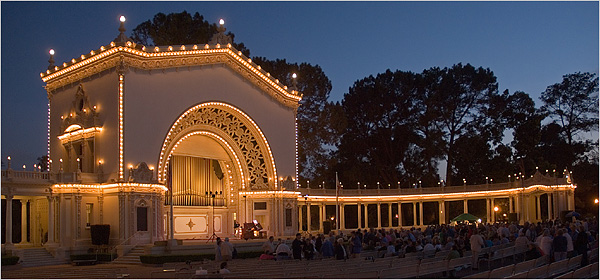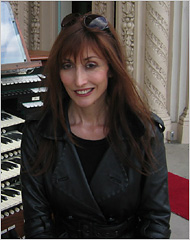|
With Jets Providing Accompaniment a Rare City Treasure Stands Exposed  Photo: Robert Harrington for The New York
Times
The organ played by Dr. Carol Williams, San Diego’s civic
organist, is sheltered by only a pavilion. By CRAIG R. WHITNEY Published: April 28, 2007 New Yok Times SAN DIEGO — Playing the organ in cold churches never daunted Carol Williams in England, where she grew up and decided to become a concert performer.  Photo: Craig R. Whitney for The New York
Times Photo: Craig R. Whitney for The New York
TimesDr. Williams at the console of the Spreckels Organ. But playing the organ in sunny Southern California, where she became the civic organist of San Diego in 2001, has often been a surprisingly chilling experience: The organ she plays here is one of the few in the world that stand out in the open. “The wind can blow your hair back,” she said. “It’s the coldest I’ve ever played.” Kneading a beanbag that she had heated in a microwave, she was warming her fingers recently for one of her regular Sunday afternoon concerts on the instrument, the Spreckels Organ. Its 4,518 pipes speak from a “pavilion” in Balboa Park, which opened on New Year’s Eve in 1914, for an exposition celebrating the completion of the Panama Canal. San Diegans boast that it is the largest outdoor pipe organ in the country, though the Chautauqua Institution in upstate New York has a larger one in an open-air auditorium — but it has a roof. The pavilion here shelters the pipes from the elements, but the audience and the organist sit under the sky. (The console fits behind a 10-ton iron curtain that comes down between concerts.) Donated by John D. and Adolph B. Spreckels, heirs to a sugar fortune, the organ is owned by the city of San Diego, one of the few still maintaining an old American tradition of having an organist on the city payroll. San Diego will pay about $68,000 this year in one way or another for music in the pavilion, including half the civic organist’s salary and a contribution to the Spreckels Organ Society, which pays the rest and organizes summer evening concerts under Dr. Williams’s direction — all part of a unique city treasure, according to George Biaggi, the deputy press secretary to Mayor Jerry Sanders. “We’re strong supporters,” Mr. Biaggi said, despite a long-running city budget crisis. Dr. Williams, who earned her doctorate at the Manhattan School of Music in 2001, works the organ’s four keyboards and pedal board out in the elements, often in a chill Pacific breeze. The organ can be stentorian and can more than hold its own, even with the jet planes roaring into the airport down the hill. Adults, children, even dogs, attracted by the sound, drift in and sit in the sun — or wrap up against the ocean breeze — and listen. “They’ll probably hear this in New York City,” Dr. Williams told them the other day before tearing into a toccata, tossing her long black hair and showing a bit of leg as she jumped up onto the organ bench. Lyle W. Blackinton, the organ curator, keeps the pipes in tune, the vagaries of weather permitting, and helps Dr. Williams keep her music sheets from blowing away. By the time she finished a program that also included a work by the contemporary Welsh composer Karl Jenkins, a transcription of Duke Ellington’s “Solitude” and the early-20th-century French organist Louis Vierne’s “Carillon de Westminster,” on the theme of Big Ben’s chimes, a couple of hundred people were listening. The special summer concerts draw up to 4,200. “Even when it’s a rainy Sunday, people will gather onstage,” she said. She starts every concert with an arrangement of “America the Beautiful” and finishes with “The Star-Spangled Banner,” ending with a crash of cymbals (real ones that are part of the instrument; the organ also has a stop that imitates a harp). “Sunday afternoons have to be, in a way, entertaining,” she said, “but there’s nothing wrong with that. The organ has a future, if people play what audiences want to listen to.” Among the pieces she has played are “How Much Is That Doggie in the Window?” and “Mad Dogs and Englishmen,” at a concert in February called “Bark in the Park,” a benefit for the San Diego Humane Society. It was a jazz electronic organ that belonged to an aunt in England, near her parents’ home southwest of London, near Aldershot, that got her hooked on the instrument. “I had started piano at age 5, but then when my aunt bought the organ, that was it,” she said. “I grew up playing jazz organ, and then studied organ at the Royal Academy of Music.” She saw an advertisement for the civic organist post while she was finishing her doctorate in New York. Now she has a Mustang with “CIV ORG” plates, and she and her fiancé, Kerry Bell, a videographer, plan to drive up to the pavilion on Oct. 20 to be married there, with some of her predecessors doing the honors. Many cities in America had municipal organists 100 or 75 years ago, before phonographs, stereos, CD players or iPods; they hired them to play not only organ music but also transcriptions of symphonic and band music, on pipe organs built to imitate the sounds of orchestras, and keep the citizenry entertained. Tens of thousands of people flocked to hear municipal organs in places from San Francisco to San Diego, and from Chattanooga, Tenn., to Portland, Me., all with instruments by the Austin Organ Company of Hartford, which operates today as Austin Organs Inc. Outdoor organ playing has some unique challenges. The worst Dr. Williams remembers facing was a huge beetle that landed on the pedal board next to her foot one evening — “on the second page of a concerto,” she said. A fellow musician came to the rescue and brushed the beast away. Correction: May 1, 2007 A picture caption in The Arts on Saturday with an article about Carol Williams, the civic organist for San Diego, carried an erroneous credit. The photograph, of the organ she plays and the pavilion that shelters it, was by Robert Harrington, not Donald MacKenzie. Back to Plaudits page |